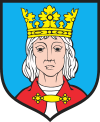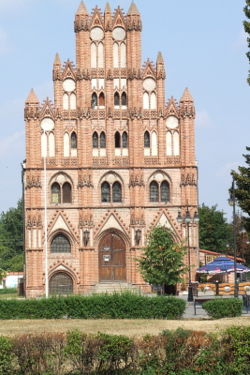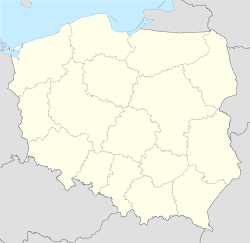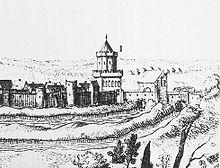- Chojna
-
For other places with the same name, see Chojna (disambiguation).
Chojna Gothic Town Hall 
Coat of armsCoordinates: 52°58′N 14°25′E / 52.967°N 14.417°E Country  Poland
PolandVoivodeship West Pomeranian County Gryfino Gmina Chojna Town rights 1255 Government - Mayor Adam Fedorowicz Area - Total 12.12 km2 (4.7 sq mi) Population (2006) - Total 7,187 - Density 593/km2 (1,535.8/sq mi) Time zone CET (UTC+1) - Summer (DST) CEST (UTC+2) Postal code 74-500 Area code(s) +48 91 Car plates ZGR Website http://www.chojna.pl Chojna [ˈxɔi̯na] (German: Königsberg in der Neumark; Kashubian: Kùńzberch; Latin: Regiomontanus Neomarchicus) is a small town in western Poland in the West Pomeranian Voivodeship. It lies approximately 60 km south of Szczecin and participates in the Douzelage.
Chojna is located near two border crossings (Bad Freienwalde and Schwedt) on the Oder River with Germany.
Contents
History
High Middle Ages
From the 10th-12th centuries an early Pomeranian fortification, probably with a market, developed at the location of present-day Chojna. Because of its favorable location on trading routes leading to the principalities of Great Poland and the duchies of Pomerania, the settlement developed quickly. Duke Boguslaw I of Pomerania was entombed in the settlement's church after his death in 1187. After 1200 the settlement received Magdeburg rights from Duke Barnim I the Good. It was referred to as "Konigesberge" for the first time in 1244 and passed to the Bishopric of Brandenburg after its acquisition of part of the Neumark in 1252. Populated with German knights and colonists, the town's name "Konigesberge" evolved into the later German name "Königsberg" ("King's Mountain"). After the cession of the "terra Konigesberge" from the Bishops of Brandenburg to the Ascanian Margraves of Brandenburg, the town was granted the right to hold a market as well as regional legal jurisdiction, causing it to become the main town of the Neumark at that time.
Late Middle Ages
A parish church by existed by 1282, while an Augustian monastery was founded in 1290. From 1310-1329 Königsberg experienced an economic boom through the trade of corn, allowing the town to receive further market privileges. The town hall was built in 1320. Trade goods were shipped over the Oder and Röhricke rivers. During the 13th and 14th centuries a defensive wall was built around the town with numerous towers and three city gates (Schwedter Tor, Bernikower Tor, and Vierradener Tor, the latter demolished in the 19th century). From 1402-1454 Königsberg was under the control of the Teutonic Knights after the pawning of the Neumark by Brandenburg. The Church of St. Mary and the reconstructed town hall (1410) built during this time were some of the most aesthetic Gothic buildings in the Neumark.
Renaissance
The strong town withstood an attack by the Hussites in 1433 during the Hussite Wars. The town flourished economically during the German Renaissance beginning in the 15th century, but the majority of its population died from three plagues during the 16th and 17th centuries. Königsberg had several churches: the Augustinian monastery church, the Augustinian hospital church of the Holy Spirit, and the Churches of Saints Mary, Nicholas, George, and Gertrude. The town gradually converted to Lutheranism from 1539-1553 during the Protestant Reformation, resulting in the dissolution of the monastery in 1536. Its buildings were instead used as a hospital and school, while its church was used as a storehouse. During the Thirty Years' War, Königsberg was occupied at different times by the Imperial troops of Albrecht von Wallenstein and the Swedish troops of King Gustavus Adolphus, in the course of which the town was 52% destroyed. After the destruction of the Church of St. Mary's tower by a lightning bolt in 1682, reconstruction commenced until 1692.
Early modern age
A new Baroque pulpit was built in 1714, as well as an organ built by Joachim Wagner in 1734. Königsberg began to revive economically after the foundation of the Kingdom of Prussia, becoming the seat of the government of the Neumark in 1759 during the Seven Years' War. In 1767 the Schwedter and Bernikower Gates were partially dismantled to provide stone for the construction of a barracks at the former monastery. The town's inhabitants initially specialized in agriculture and forestry and later in the weaving of fine textiles. That industry declined, however, around 1840 with the onset of industrialization. Königsberg became the seat of the district Landkreis Königsberg Nm. in 1809 and part of the Province of Brandenburg in 1816. The former monastery buildings began to deteriorate in 1820. Königsberg became part of the German Empire in 1871 and flourished after being connected to a railway network in 1877. The town also served as an education and administrative seat for the surrounding region.
World War II
In 1939 the Luftwaffe constructed an airfield near the gates of Königsberg. In January 1945 battles on the Eastern Front of World War II occurred near the town. Because he had fled the town without issuing a general evacuation order, the buergermeister of Königsberg was condemned to death by hanging on February 4, 1945 by an SS court martial chaired by Otto Skorzeny. On the same day the Soviet Red Army occupied the town. The entire center with the Church of St. Mary and the town hall were burnt on February 16, 1945; Königsberg was 80% destroyed during the war. Upon war's end Königsberg was placed under Polish administration, had its German population expelled, and was renamed Chojna.
Poland
Vestiges of the war are still visible in some of Chojna's buildings. The foundation wall of the destroyed town hall was rebuilt for use as a cultural center, town library, and public house. The monastery was also reconstructed, while the marketplace was newly built. Reconstruction of the destroyed Marienkirche began in 1994 as a joint German-Polish cooperation. In 1997 the roof of the church's nave was covered, while the pyramidal tower roof of the tower was reconditioned in a 19th century Neo-gothic style. Chojna's two main landmarks are thus the town hall and the Church of St. Mary, both historical buildings by the Gothic architect Hinrich Brunsberg.
Sights
Chojna is on The European Route of Brick Gothic.
- Cathedral
- The Augustinian monastery and the remains of the city wall with the Schwedter and Bernikower Gates.
- Enormous platanus.
International relations
Twin towns - Sister cities
Chojna is a member of the Douzelage, a unique town twinning association of 24 towns across the European Union. This active town twinning began in 1991 and there are regular events, such as a produce market from each of the other countries and festivals.[1][2] Discussions regarding membership are also in hand with three further towns (Agros in Cyprus, Škofja Loka in Slovenia, and Tryavna in Bulgaria).
 Altea, Spain - 1991
Altea, Spain - 1991 Bad Kötzting, Germany - 1991
Bad Kötzting, Germany - 1991 Bellagio, Italy - 1991
Bellagio, Italy - 1991 Bundoran, Ireland - 1991
Bundoran, Ireland - 1991 Granville, France - 1991
Granville, France - 1991 Holstebro, Denmark - 1991
Holstebro, Denmark - 1991 Houffalize, Belgium - 1991
Houffalize, Belgium - 1991 Meerssen, the Netherlands - 1991
Meerssen, the Netherlands - 1991 Niederanven, Luxembourg - 1991
Niederanven, Luxembourg - 1991 Preveza, Greece - 1991
Preveza, Greece - 1991 Sesimbra, Portugal - 1991
Sesimbra, Portugal - 1991 Sherborne, United Kingdom - 1991
Sherborne, United Kingdom - 1991 Karkkila, Finland - 1997
Karkkila, Finland - 1997 Oxelösund, Sweden - 1998
Oxelösund, Sweden - 1998 Judenburg, Austria - 1999
Judenburg, Austria - 1999 Chojna, Poland - 2004
Chojna, Poland - 2004 Kőszeg, Hungary - 2004
Kőszeg, Hungary - 2004 Sigulda, Latvia - 2004
Sigulda, Latvia - 2004 Sušice, Czech Republic - 2004
Sušice, Czech Republic - 2004 Türi, Estonia - 2004
Türi, Estonia - 2004 Zvolen, Slovakia - 2007
Zvolen, Slovakia - 2007 Prienai, Lithuania - 2008
Prienai, Lithuania - 2008 Marsaskala, Malta - 2009
Marsaskala, Malta - 2009 Siret, Romania - 2010
Siret, Romania - 2010
References
 This article incorporates text from a publication now in the public domain: Chisholm, Hugh, ed (1911). Encyclopædia Britannica (11th ed.). Cambridge University Press.
This article incorporates text from a publication now in the public domain: Chisholm, Hugh, ed (1911). Encyclopædia Britannica (11th ed.). Cambridge University Press.- This article contains information translated from the German Wikipedia's Chojna article, accessed May 26, 2006.
Bibliography
- H.-G. Bluhm, W. Pflug, B. Regenberg, R. H. Tamm (Hrsg.). Kreis Königsberg/Neumark, Erinnerungen an einen ostbrandenburgischen Landkreis. Berlin / Bonn, 2. Aufl., 1997, ISBN 3-929592-13-4.
Notes
- ^ "Douzelage.org: Home". www.douzelage.org. http://www.douzelage.org/. Retrieved 2009-10-21.
- ^ "Douzelage.org: Member Towns". www.douzelage.org. http://www.douzelage.org/index.php?id=15. Retrieved 2009-10-21.
External links
- Municipal website (Polish)
- Reconstruction of the Church of St. Mary (German)
- Genealogical information about Königsberg in der Neumark (German)
Coordinates: 52°58′N 14°25′E / 52.967°N 14.417°E
Town and seat Chojna
Villages Bara • Barnkowo • Białęgi • Boguszczyn • Brwice • Czartoryja • Drozdowo • Garnowo • Godków • Godków-Osiedle • Grabowo • Graniczna • Grzybno • Jelenin • Jelonki • Kaliska • Kamienny Jaz • Krajnik Dolny • Krajnik Górny • Krupin • Krzymów • Kuropatniki • Łaziszcze • Lisie Pola • Lisie Pole • Mętno • Mętno Małe • Narost • Nawodna • Ognica • Ostrów • Pniewko • Przyciesie • Raduń • Rurka • Stoki • Strzelczyn • Strzeszewko • Trzeszcze • Wilcze • Wilkoszyce • Zatoń DolnaEuropean Union · Members of the town twinning "Douzelage"  Categories:
Categories:- Cities and towns in West Pomeranian Voivodeship
- Gryfino County
Wikimedia Foundation. 2010.





